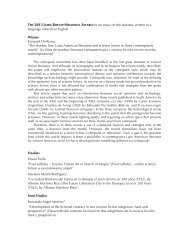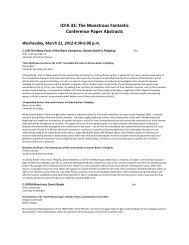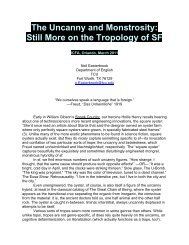a serpent cause her to doubt her very species? By examining this passage from Through the Looking-Glass in the context of Victorianperceptions of childhood and of monstrosity, I complicate our understanding of what it meant to be both child and monster in the age of thecult of childhood.<strong>Monstrous</strong> Responses to Charles Finney’s <strong>The</strong> Circus of Dr. LaoDaniel CreedBroward CollegeSince 1935, <strong>The</strong> Circus of Dr. Lao has been examined in few critical studies. While the text has been ignored for many reasons, Finney’s work iswritten in a seemingly disjointed style of vignettes that seem “more familiar today than when it was originally published” (Wolfe 283).However, Finney’s novel is not disjointed, but well organized. <strong>The</strong> order in which the characters encounter the advertisement for the circus inthe morning paper is the same order their episodes occur within the circus, implying a carefully crafted order of perception and reception ofthe fantastic. Through their interactions with the fantastic, the residents of Abalone, Arizona, (and readers of the text) tap into a desire tocommune with creatures of nature that are more powerful, more pure, and more fantastic than they; to traverse space and time, examiningtheir lives from an immortal point of view. Here is the world of the fairy-story, where man is monstrous (Frank Tull provides a very thoroughexample) and the fantastic is natural (the Hound of the Hedges), written in a style that is similar to attending the circus itself. <strong>The</strong> vignettes areechoes of the multiple acts of the circus, and readers confronting the text need to imagine themselves in the auditorium of a modern circus,where acts enter, perform, and leave, culminating in the main event, where the short acts they have witnessed previously converge intosomething grander. It is through the small acts that Finney expresses his displeasure with the hypocrisy and complacency of 1930s Americansociety, and in the main event (Woldercan) his attitude about his primary world is evident, for what saves Woldercan has failed in Abalone,because the people refused to believe, to sacrifice their preconceptions and prejudices and embrace the fantastic when they were presentedwith it.28. (PCS) Dark Lords and Creatures of <strong>The</strong> Night: <strong>The</strong> <strong>Monstrous</strong> in Fandom Vista BChair: Karen HelleksonIndependent ScholarNormalizing the Monster and Marginalizing the Reader: Twilight as Popular RomanceKelly BudruweitWestern Illinois University<strong>The</strong> presentation focuses on close readings of a selection of fan fictions (amateur-authored, Internet-published stories) based on vampire textworlds. Although a general ‘rule’ in fan fiction is to stay true to the logic of the fictional universe the fanfic authors write about, fanfic texts alsoillustrate resistance to elements in it. Of particular interest is the resistance to the de-fangedness of contemporary romantic vampires whocontrol their bloodlust and integrate themselves in human societies where they often function as protectors of the less powerful humans. Invampire fan fiction, based on True Blood, Twilight, and <strong>The</strong> Vampire Diaries, there is a clear tendency to recuperate the danger and monstrosityof the trope: to leave the vampire fanged, once again. Re-fanging the vampire in fan fiction implies reclaiming its predatory status as well as theamorality connected to both bloodlust and the transgressive sexuality traditionally associated with vampires. Of interest is therefore how thereworked, dangerous vampire in the fanfic texts comes to resemble the marginalized but fascinating monster of earlier periods. Incontemporary vampire texts, metaphysical issues are central, and often linked to the theme of the soulless vampire. <strong>The</strong> choice of a morallyresponsible life which contemporary vampires such as Edward Cullen, Stefan Salvatore and Bill Compton make is largely based on theirconviction that transformation into a vampire entails a loss of the human soul and, thus, eternal damnation: moral and metaphysical issueswhich are variously negotiated in fan fictions featuring re-fanged vampires. Through analyses of fanfics narrated from a predatory vampire’spoint of view I discuss which characteristics and values fan fiction authors associate with the re-fanged vampire and highlight which aspects ofthe contemporary text worlds fanfic authors challenge through their reworkings.Re-fanged Monsters: Good, Evil and the Search for a Soul in Vampire Fan FictionMaria LeavenworthUmeå UniversityTwilight is one form of escapism that has been difficult to escape. Often, in spite of attempts at resistance, readers have found themselvesinexorably drawn into the magnetic field of a world which promises passion without any of the usual drawbacks, like change or death. If, asPeter Brooks asserts, “plot is the internal logic of the discourse of mortality” (Reading for the Plot 22), then we might assume that it isn’t thedesire for the plot which drives readers to inhale Twilight at high speeds. Rather, it might be the opportunities for identification with theprotagonist, which provide a world in which all desires are fulfilled, and fulfilled forever. However, in spite of the possibilities offered by variousTwilight-centered cultural experiences, this fantasy cannot last forever. Thus, my presentation would focus on answering the question: Whathappens to readers of Twilight when the last page is turned? With a view to answering this question, I will examine the normalization of themonstrous, which occurs to the degree that the books can hardly fit within the horror genre. Instead, what we have may be a slightly scaryromance. Thus, the experience of reading Twilight could be understood better from the perspective of Janice Radway’s Reading the Romance,a study of (primarily) middle-aged women who spend their free-time reading romance novels. Meanwhile, I will also attempt to illuminate thecomplex relationship between reader identifications of the “gothic” and the “romantic,” drawing on Michael Gamer’s study of canon formationduring the late 18th/early 19th centuries. Such a reading might account for the way that, in divesting vampires of their monstrous qualities,Stephenie Meyers divests the monstrous of its subversive potential.
Taking the Monsters out of the Closet: Sith and Sex in Star Wars Fan FictionSarah CarpenterGeorge Mason UniversityEver since the release of A New Hope in 1977, Star Wars fans have known that “Vader was seduced by the Dark Side of the Force.” (Lucas) In2005, Revenge of the Sith embodied that seduction in Supreme Chancellor Palpatine, who lured young Anakin Skywalker with false promises.<strong>The</strong>ir interactions on screen are charged with a homoerotic subtext that causes many fans to read against the grain of the official Star Warscanon, producing narratives that bring forward that subtext and render the (presumably) metaphorical seduction literal. Such narratives tendto focus on the monstrous nature of Anakin’s seduction on two fronts: the unequal power dynamic established through Anakin’s youth andPalpatine’s fatherly role, and the physical transformation of each man into a monster at the end of Revenge of the Sith. I analyze specific fanfiction texts shared by fan fiction writers in the popular blogging platform LiveJournal.com and examine the ways in which these writersintervene in the canonical subtext to develop their own narratives that use the Sithly dyad to interrogate power relationships, problematizeconceptions of masculinity, and enhance, celebrate, and redeem two monsters and their sex. Drawing on gender theory and audience studiesthat explore negotiated meanings as I closely read these fannish texts, I argue against popular conceptions of the Star Wars fandom asinherently heteronormative and hegemonic to demonstrate instead that the fannish tradition provides a space for resistant readings andproductions of meaning.*******Thursday, March 22, 2012 2:30-3:30 pm.30. (IF/FTV) Recycling as Resistance and Genre Innovation PineChair: Terry HarpoldUniversity of FloridaC’est de la récup”: Recycling as Resistance in Jeunet’s Delicatessen and MicmacsElizabeth McManusNorthwestern UniversityJean-Pierre Jeunet’s films, from the post-apocalyptic Delicatessen (1991) to the crowd-pleasing Amélie (2001), conjure an ethereal France of abygone era. While his most recent film, Micmacs (2009), is set in contemporary France, the protagonist and his motley group of friendsembody a figure from France’s past: the rag-picker who, until the 1960’s, survived by collecting trash to be reused. Out of place in modernParis, this anachronistic figure revives old France, the nostalgia for which colors all of Jeunet’s films. <strong>The</strong> rag-picker is also important for thework that he performs on rubbish. In this paper, I will argue that recycling and reusing rejected objects is a subversive act used to underminethe inhumanity perpetrated by a cannibalistic butcher in Delicatessen and international arms dealers in Micmacs. In Delicatessen disparatesounds are recycled into music and in Micmacs metal scraps are reworked into animated animal or human forms; reusing rubbish becomes away to appropriate and re-humanize unwanted objects. “La récup” (salvaged material) thus fosters a community that ultimately counteractsthe brutality of the tyrannical butcher and the amoral arms dealers. To better understand Jeunet’s portrayal of recycling as resistance todehumanization, I will compare it to recycling and the rag-picker in Jacques Tati’s Mon Oncle (1958). In Tati’s film, the rag-picker is anintermediary between traditional Paris and modern Paris, and the impetus behind new meetings and connections made throughout the film.While Delicatessen and Micmacs seem to develop this idea, Jeunet’s brand of nostalgia for old France, criticized as “politically disturbing” and“regressive,” renders the image of the rag-picker resisting dehumanization rather problematic: how can a precarious means of survival besubversive? What is ultimately at stake in critiques of Jeunet’s nostalgia is the question of how we are to read the fantastic in relation to ourown world.A History of French Literature from 1966 to 2060: Michel Jeury’s Le Temps IncertainBrittany MurrayNorthwestern UniversityMichel Jeury’s Le Temps Incertain (1973) recounts a time-traveler’s journey to the year 1966. His task is to establish communication betweenpast and future. <strong>The</strong> novel might be said to perform a function similar to that of its protagonist. Looking backward, its innovative formalstructure has invited comparison to the nouveau roman, a “high literary” experminent of the 1950s and 1960s. Looking forward, Le TempsIncertain also precipitated the “new” French Science Fiction movement of the 1970s. In this paper, I will argue that Jeury’s novel re-reads olderaeshetic forms in order to formulate a new literary project. Amidst a future war over the dimensions of “uncertain” time, Jeury’s time-traveleris sent to investigate a past crime that can only be perceived as a single scene repeated on loop. <strong>The</strong> protagonist’s task is to preserve themutability and oppenness of history from within a perspective where time appears to be the inevitable repetition of the same. First, I willcompare this novel to Robbe-Grillet’s Les Gommes (1953) in order to highlight how Le Temps Incertain offers an implicit critique of the nouveauroman. While Les Gommes recounts the story of a detective who becomes complicit in the crime he is investigating, the circular structure ofRobbe-Grillet’s novel becomes complicit in the problem that Jeury’s protagonist investigates twenty years later. <strong>The</strong>n, I will discuss how LeTemps Incertain’s protagonist raises the question that will face the “new” French Science Fiction: can older literary forms be recycled and repurposedin order to formulate a new genre?
- Page 4 and 5: 5. (F) Wondrous Bodies of the Gende
- Page 6 and 7: Fantastic Suicide: Reading the Unca
- Page 8: Viral Posthumanism: Boundaries and
- Page 11 and 12: The Concept of Soul Divisibility in
- Page 13 and 14: Thursday, March 22, 2012 10:30 a.m.
- Page 15 and 16: 21. (CYA) Terrifying Futures: Post-
- Page 17 and 18: 23. (FTV/H) Now I’m Feelin’ Zom
- Page 19: Fight Club: Amalgam of the Horrific
- Page 23 and 24: Kaspar J. SaxenaIndependent Scholar
- Page 25 and 26: 44. (CYA) The Monstrosity of Teenag
- Page 27 and 28: 46. (FTV/SF) Monstrous Spin-offs: T
- Page 29 and 30: 49. (F) Aspects of Miéville Captiv
- Page 31 and 32: 53. (SF) War and Crisis in 1940s an
- Page 33 and 34: Abuse of Power: An Evolutionary Res
- Page 35 and 36: Disappearing Natives: The Colonized
- Page 37 and 38: 60. (H/IF) Ancient and Medieval Mon
- Page 39 and 40: 62. (F) The Works of Tolkien Captiv
- Page 41 and 42: 67. (SF) Imperial and Postcolonial
- Page 43 and 44: Beheading the Gorgon: Beautifying C
- Page 45 and 46: 71. (VPA) Monstrous Music MagnoliaC
- Page 47 and 48: 73. (F/IF) Portraying New Worlds Ca
- Page 49 and 50: Friday, March 23, 2012 2:45-3:45 pm
- Page 51 and 52: 81. (FTV) Those Damn Dirty Apes! Cy
- Page 53 and 54: Friday, March 23, 2012 4:00-5:30 pm
- Page 55 and 56: 92. (F) Leaving the Demonized Other
- Page 57 and 58: 94. (FTV/CYA) Monstrosity and Devia
- Page 59 and 60: of cannibalism, ghostly seduction i
- Page 61 and 62: Saturday March 24, 2012 8:30-10:00
- Page 63 and 64: 104. (CYA) Classic Monsters, Reinte
- Page 65 and 66: 107. (VPA) Monstrous Gaming Bodies
- Page 67 and 68: who challenge the order that the Br
- Page 69 and 70: Reading Between the Times: A Critic
- Page 71 and 72:
117. (FTV) Monsters and Superheroes
- Page 73 and 74:
119. (IF/H/PCS) International Mash-
- Page 75 and 76:
Focusing on Stoker's Dracula as one
- Page 77 and 78:
Florida Atlantic UniversitySheri S.
- Page 79 and 80:
Simmons CollegeIn the spate of rece
- Page 81 and 82:
Independent ScholarKing’s story
- Page 83 and 84:
modernity opens up for every indivi
- Page 85 and 86:
Saturday March 24, 2012 4:00-5:30 p
- Page 87 and 88:
141. (FTV) Monstrous Masculinity Cy
- Page 89 and 90:
ultimately make peace with her mons
- Page 91 and 92:
where the almost-human sentient zom





